智能快递柜项目盈利风险研究
智能快递柜的盈利对策探究

收稿日期 '$%( )%' )%$ !基金项目大学生创新创业项目安徽省省级项目$项目编号为 `S'$%#$"IH$I' 作者简介 阙宏伟!%++H# " $女$硕士研究生$安徽农业大学经济管理学院在读$研究方向%金融学与管理学&
第 &期
' <"= 7(%5#( 4/<-0@.E)3-.8603.6;0)>2729.3/2;0>6-2506.;)41<-6;:25.;./A
#A引言 电子商务的迅猛发展极大程度上带动了快递业的发展$
据国家邮政局的数据统计$'$%I 年快递支撑网络零售额超过 H 万亿元$占社会消费品零售总额比重达到 %'B#R& '$%I 年 我国快递发展指数为 #"&B#$同比提高 H$B&R& 预计 '$%( 年 我国快递业务量达到 H'" 亿件$同比增长 "#R)快递业收入将 完成 #%I# 亿元$同比增长 "$R& 巨大的市场份额吸引了大量 投资者将目光对准快递业的最后一公里$这也使得智能快递 柜应运而生&
综上$笔者认为通过分析智能快递柜现有的盈利模式$改 进现有模式中不利因素$寻找适合智能快递柜可持续发展的 新盈利点对快递业来说具有现实和借鉴意义& 为此$笔者调 查走访了以安徽农业大学为辐射中心的周边社区和相关企
业$针对智能快递柜如何更好发展提出对策& !A国内现状 'B%!智能快递柜的运营模式
智能快递柜从 '$%' 年初次面世到 '$%( 年经过 # 年的发 展$已经逐渐形成三种成熟的运营模式& 'B%B%!电商企业自建自营
智能快递柜行业分析报告
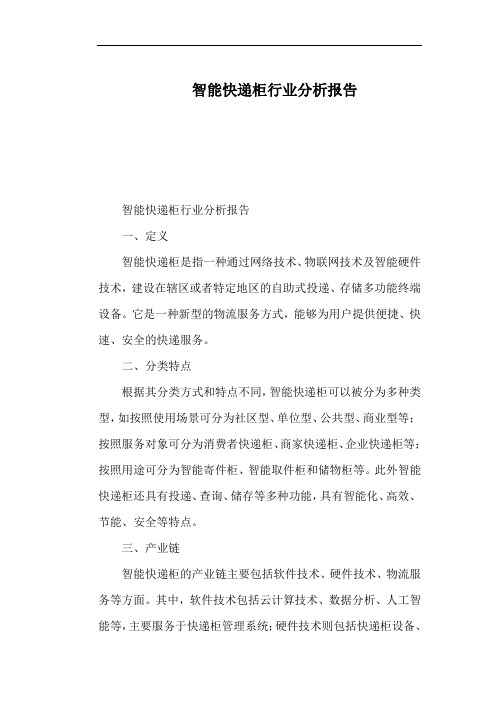
智能快递柜行业分析报告智能快递柜行业分析报告一、定义智能快递柜是指一种通过网络技术、物联网技术及智能硬件技术,建设在辖区或者特定地区的自助式投递、存储多功能终端设备。
它是一种新型的物流服务方式,能够为用户提供便捷、快速、安全的快递服务。
二、分类特点根据其分类方式和特点不同,智能快递柜可以被分为多种类型,如按照使用场景可分为社区型、单位型、公共型、商业型等;按照服务对象可分为消费者快递柜、商家快递柜、企业快递柜等;按照用途可分为智能寄件柜、智能取件柜和储物柜等。
此外智能快递柜还具有投递、查询、储存等多种功能,具有智能化、高效、节能、安全等特点。
三、产业链智能快递柜的产业链主要包括软件技术、硬件技术、物流服务等方面。
其中,软件技术包括云计算技术、数据分析、人工智能等,主要服务于快递柜管理系统;硬件技术则包括快递柜设备、传感器、控制系统、通讯技术等,主要服务于智能快递柜系统;物流服务则包括快递企业、快递员、维护服务等,主要服务于快递运输以及智能快递柜的日常运营。
四、发展历程智能快递柜起源于2003年,是由深圳市安可信电子技术有限公司研发制造的设备。
2010年,京东在北京城内的500个社区推出了自己研发的“送哥”智能快递柜。
2011年,顺丰开始试水快递柜业务。
自此,越来越多的快递公司纷纷进入智能快递柜业务领域,加速了智能快递柜的发展。
2015年,国家邮政局正式发布《快递行业规范》文件,对快递柜领域的业务进行了明确的规范和办理流程。
五、行业政策文件及其主要内容《快递行业规范》文件是行业政策文件之一,主要包括管理规定、设备标准、操作规范等内容,通过对智能快递柜运营、服务标准、安全管理等方面进行规范,进一步增强了智能快递柜的管理效率,推进了快递产业的规范化和可持续发展。
六、经济环境随着电商的快速发展,大量的物流需求快速增长,这也促进了智能快递柜市场的快速增长。
在经济形势下,智能快递柜行业面临的压力不仅来自高投资、高维护成本,更在于成本控制、企业盈利策略等市场环境方面的问题。
智能快递柜的SWOT分析与发展建议

智能快递柜的SWOT分析与发展建议智能快递柜是一种通过智能科技实现快速快递存取的设备,可以提高快递配送效率,提高用户体验,减少人力成本,是现代快递行业的一种创新型解决方案。
智能快递柜的出现为我们的生活带来了诸多便利,但同时也存在着一些问题和挑战。
下面将对智能快递柜进行SWOT分析,并提出相应的发展建议,以期对智能快递柜的未来发展做出客观的评估和建议。
1. 优势(Strengths)a. 提高配送效率:智能快递柜可以提高快递配送效率,缩短配送时间,减少人力成本。
b. 便捷的取件方式:用户可以随时随地通过手机或者密码取件,大大提高了用户体验。
c. 减少错派和遗失:快递员代收环节减少,减少错派和遗失的可能性。
d. 减少末端配送环节:可以实现集中投递、末端派送一次到位,减少末端配送环节,提高配送效率。
2. 劣势(Weaknesses)a. 技术成本高:智能快递柜的制造和维护成本较高,需要投入大量的资金。
b. 对场地要求高:智能快递柜需要占用一定的场地,并且需要有稳定的电源供应。
c. 安全隐患:智能快递柜的安全性需要得到保障,否则可能会引发盗窃等问题。
d. 用户体验不佳:部分智能快递柜的使用流程复杂,用户体验不够友好。
3. 机会(Opportunities)a. 市场需求增长:随着电商行业的快速发展,快递业务量增长迅速,智能快递柜有望迎来更大的市场需求。
b. 技术升级:随着物联网、大数据等技术的不断发展,智能快递柜有望实现更多的智能化功能,提高用户体验。
4. 威胁(Threats)a. 行业竞争激烈:智能快递柜市场竞争激烈,存在市场份额被竞争对手抢占的风险。
b. 政策法规限制:政府对于智能快递柜所在区域的规定可能会对其发展造成限制。
c. 安全风险:智能快递柜可能存在被破坏或盗窃的安全风险。
d. 技术更新换代:随着技术的不断发展,智能快递柜需要不断跟进更新技术,否则会落后于时代。
二、智能快递柜的发展建议1. 加强技术创新:智能快递柜行业需要不断加强技术创新,提高产品的智能化程度和安全性,以满足用户需求。
智能快递柜盈利模式分析报告
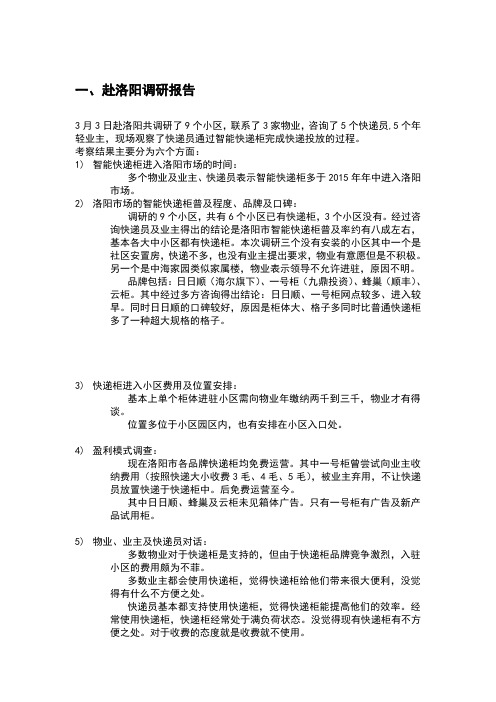
一、赴洛阳调研报告3月3日赴洛阳共调研了9个小区,联系了3家物业,咨询了5个快递员,5个年轻业主,现场观察了快递员通过智能快递柜完成快递投放的过程。
考察结果主要分为六个方面:1)智能快递柜进入洛阳市场的时间:多个物业及业主、快递员表示智能快递柜多于2015年年中进入洛阳市场。
2)洛阳市场的智能快递柜普及程度、品牌及口碑:调研的9个小区,共有6个小区已有快递柜,3个小区没有。
经过咨询快递员及业主得出的结论是洛阳市智能快递柜普及率约有八成左右,基本各大中小区都有快递柜。
本次调研三个没有安装的小区其中一个是社区安置房,快递不多,也没有业主提出要求,物业有意愿但是不积极。
另一个是中海家园类似家属楼,物业表示领导不允许进驻,原因不明。
品牌包括:日日顺(海尔旗下)、一号柜(九鼎投资)、蜂巢(顺丰)、云柜。
其中经过多方咨询得出结论:日日顺、一号柜网点较多、进入较早。
同时日日顺的口碑较好,原因是柜体大、格子多同时比普通快递柜多了一种超大规格的格子。
3)快递柜进入小区费用及位置安排:基本上单个柜体进驻小区需向物业年缴纳两千到三千,物业才有得谈。
位置多位于小区园区内,也有安排在小区入口处。
4)盈利模式调查:现在洛阳市各品牌快递柜均免费运营。
其中一号柜曾尝试向业主收纳费用(按照快递大小收费3毛、4毛、5毛),被业主弃用,不让快递员放置快递于快递柜中。
后免费运营至今。
其中日日顺、蜂巢及云柜未见箱体广告。
只有一号柜有广告及新产品试用柜。
5)物业、业主及快递员对话:多数物业对于快递柜是支持的,但由于快递柜品牌竞争激烈,入驻小区的费用颇为不菲。
多数业主都会使用快递柜,觉得快递柜给他们带来很大便利,没觉得有什么不方便之处。
快递员基本都支持使用快递柜,觉得快递柜能提高他们的效率。
经常使用快递柜,快递柜经常处于满负荷状态。
没觉得现有快递柜有不方便之处。
对于收费的态度就是收费就不使用。
6)快递柜派件效率及逾期不取的快件处理办法现场观察快递员使用快递柜完成七八件快递投递耗时仅为两分钟,快递员觉得很方便没发现不方便之处。
智能快递柜的盈利模式研究
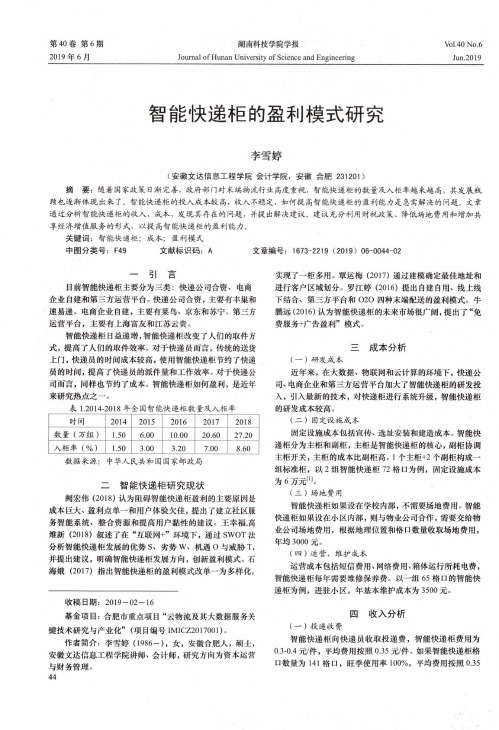
第40卷第6期2019年6月湖南科技学院学报Journal of Hunan University of Science and EngineeringVol.40No.6Jun.2019智能快递柜的盈利模式研究李雪婷(安徽文达信息工程学院会计学院,安徽合肥231201)摘要:随着国家政策日渐完善,政府部门对末端物流行业高度重视,智能快递柜的数量及入柜率越来越高,其发展瓶颈也逐渐体现出来了.智能快递柜的投入成本较高,收入不稳定,如何提高智能快递柜的盈利能力是急需解决的问题。
文章通过分析智能快递柜的收入、成本,发现其存在的问题,并提出解决建议.建议充分利用财税政策、降低场地费用和增加共享经济增值服务的形式,以提高智能快递柜的盈利能力.关键词:智能快递柜;成本;盈利模式中图分类号:F49文献标识码:A文章编号:1673-2219(2019)06-0044-02—引言目前智能快递柜主要分为三类:快递公司合资、电商企业自建和第三方运营平台。
快递公司合资,主要有丰巢和速易递。
电商企业自建,主要有菜鸟、京东和苏宁。
第三方运营平台,主要有上海富友和江苏云贵。
智能快递柜日益递增,智能快递柜改变了人们的取件方式,提高了人们的取件效率。
对于快递员而言,传统的送货上门,快递员的时间成本较高,使用智能快递柜节约了快递员的时间,提高了快递员的派件量和工作效率。
对于快递公司而言,同样也节约了成本。
智能快递柜如何盈利,是近年来研究热点之一。
表1.2014-2018年全国智能快递柜数量及入柜率时间20142015201620172018数量(万组) 1.50 6.0010.0020.6027.20入柜率(%) 1.50 3.00 3.207.008.60数据来源:中华人民共和国国家邮政局二智能快递柜研究现状阙宏伟(2018)认为阻碍智能快递柜盈利的主要原因是成本巨大、盈利点单一和用户体验欠佳,提岀了建立社区服务智能系统、整合资源和提高用户黏性的建议。
智能快递柜盈利模式
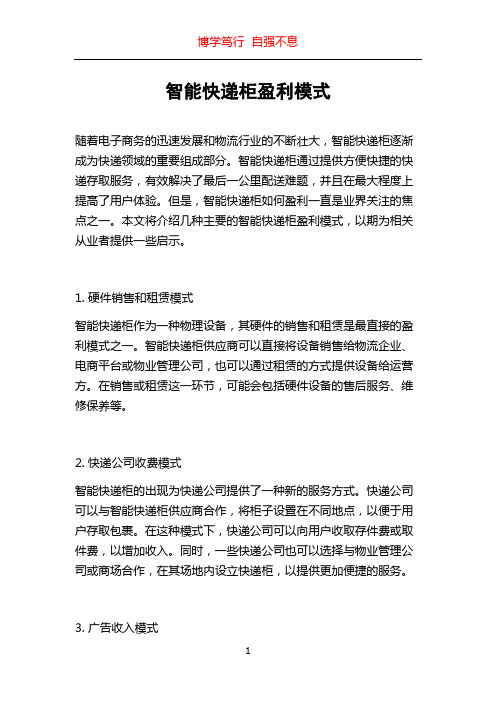
智能快递柜盈利模式随着电子商务的迅速发展和物流行业的不断壮大,智能快递柜逐渐成为快递领域的重要组成部分。
智能快递柜通过提供方便快捷的快递存取服务,有效解决了最后一公里配送难题,并且在最大程度上提高了用户体验。
但是,智能快递柜如何盈利一直是业界关注的焦点之一。
本文将介绍几种主要的智能快递柜盈利模式,以期为相关从业者提供一些启示。
1. 硬件销售和租赁模式智能快递柜作为一种物理设备,其硬件的销售和租赁是最直接的盈利模式之一。
智能快递柜供应商可以直接将设备销售给物流企业、电商平台或物业管理公司,也可以通过租赁的方式提供设备给运营方。
在销售或租赁这一环节,可能会包括硬件设备的售后服务、维修保养等。
2. 快递公司收费模式智能快递柜的出现为快递公司提供了一种新的服务方式。
快递公司可以与智能快递柜供应商合作,将柜子设置在不同地点,以便于用户存取包裹。
在这种模式下,快递公司可以向用户收取存件费或取件费,以增加收入。
同时,一些快递公司也可以选择与物业管理公司或商场合作,在其场地内设立快递柜,以提供更加便捷的服务。
3. 广告收入模式智能快递柜通常会有广告屏幕或者广告位,作为盈利的方式之一,可以向商家收取广告费用。
快递柜的地理位置通常位于人流较多的地方,比如居民小区、写字楼大厦等,这些地方通常具有较高的商业价值。
广告主可以通过在快递柜上投放广告,达到品牌宣传、产品推广的目的。
在选择广告合作时,需要考虑广告与用户体验之间的平衡,避免给用户带来过多的干扰。
4. 货架租赁模式除了作为快递柜之外,智能快递柜还可以作为货架的形式出现,以提供商品的展示和销售功能。
在这种模式下,快递柜供应商可以将货架租赁给零售商、社区团购平台或是品牌商家。
租赁费用通常会根据货架的规模、地理位置和潜在客户群体等因素而定。
5. 互联网服务模式智能快递柜的盈利模式还可以通过添加互联网服务来实现。
例如,智能快递柜可以与电商平台合作,提供自提服务,以节约配送成本。
智能快递柜盈利模式分析

智能快递柜盈利模式分析作者:赵文博来源:《合作经济与科技》2020年第15期[提要] 随着我国快递行业的爆发式增长,提高快递投递服务水平和质量成为影响快递行业发展的重要因素之一。
智能快递柜作为解决快递行业“最后一公里”问题的一种新型配送模式,能够满足用户对于快递服务多样化、个性化的需求。
本文以丰巢科技为例,阐述智能快递柜行业的服务模式和盈利模式,重点分析其亏损原因,并提出相应的建议。
关键词:智能快递柜;丰巢科技;盈利模式中图分类号:F27 文献标识码:A收录日期:2020年5月17日一、快递末端配送模式分析快递末端投递是快递服务的最后一环,由于快递业务量的不断增长,快递投递效率成为快递企业亟待解决的问题之一,快递投递的形式主要有自收和代收两种,自收就是快递员与收件人面对面进行快递交接,这种形式能够最大限度保证快递送达的准确性和及时性,但是对收件人的时间和空间要求较高,容易造成快件投递的延误,一旦收件人当天不能签收快件,需要快递员进行二次投递,严重影响投递效率和成功率。
在传统快递配送模式下,创新解决快递“最后一公里”问题成为快递企业改善快递服务水平,提高快件投递效率的关键。
新型快递配送模式逐渐应用于实际操作之中,其中最有代表性的是以阿里巴巴牵头的菜鸟驿站模式和以顺丰速运控股的丰巢智能快递柜模式,两者成为目前解决快递末端投放的主流方式。
二、丰巢智能快递柜服务模式2015年6月6日,由顺丰、申通、中通、韵达、普洛斯领航共同投资创建深圳市丰巢科技有限公司,其主要产品为丰巢智能柜,公司专注于快递自助服务,为物业公司、社区业主及快递公司、行业用户、电商企业打造的智能“快递管理终端”。
丰巢智能柜的派件方式、寄件方式、取件方式较为简便易懂,使用者能够进行方便快捷的操作。
快递员派件时录入快递信息,将快递存入适合的柜子,通知收件人到指定的快递柜取件,即完成了派件任务。
消费者取件时可以通过以下三种方法:一是当收件人收到微信、支付宝、短信其中一种取件通知时,取件人到柜机输入对应的取件码即可取出快件;二是关注丰巢快递柜的微信公众号或支付宝服务窗,绑定用户手机号,当收到取件通知时,通过微信或者支付宝扫描柜机取件二维码即可取出快件;三是当消费者忘记取件码时,可以在柜机上输入手机号,通过获取手机验证码的方式取出快件。
智能快递柜的社会效益与经济效益评估研究

目录
智能快递柜的社会效益 评估
智能快递柜的经济效益 评估
智能快递柜的社会效益 与经济效益对比分析
智能快递柜未来发展趋 势预测
结论与建议
智能快递柜的社 会效益评估
减少等待时间:智能快递柜可以24 小时提供服务,用户可以随时随地 进行取件,无需等待快递员送货上 门
完善政策法规:制定相关政策法规,规范智能快递柜的发展和管理
智能快递柜未来 发展趋势预测
人工智能技术:提高快递柜的智能化水平,实现更精准的物流配送 物联网技术:实现快递柜与用户、快递公司之间的实时信息交互 大数据分析:对快递柜使用数据进行挖掘和分析,优化快递柜布局和服务 绿色环保技术:采用环保材料和节能技术,降低快递柜对环境的影响
用对比分析方法,对智能快递柜的社会效益和经济 效益进行评估。
05 对 比 分 析 方 法 的 改 进 方 向 : 针 对 对 比 分 析 方 法 的 局
限性,可以采取一些改进措施,如加强数据收集、 提高评估标准的客观性等。
02 智 能 快 递 柜 的 社 会 效 益 与 经 济 效 益 对 比 分 析 : 通 过
消费者需求:消费者对智能快递柜的需求将不断增加,未来市场潜力巨大 竞争格局:智能快递柜市场竞争激烈,未来将出现更多创新和差异化产品 技术发展:随着技术的不断进步,智能快递柜将更加智能化、便捷化 政策环境:政府对智能快递柜行业的支持力度将不断加大,推动行业快速发展
未来政策法规变化的趋势和 预测
政策法规对智能快递柜行业 的影响
降低人力成本:智能快递柜可以减 少快递员的工作量,降低人力成本, 提高快递公司的运营效率
添加标题
添加标题
添加标题
快递柜项目风险管理的内容包括

快递柜项目风险管理的内容包括一、前言随着电商的兴起,快递业务也得到了空前的发展。
为了更好地满足人们对快递服务的需求,快递柜项目应运而生。
然而,快递柜项目也面临着各种风险,需要进行有效的风险管理。
本文将从以下几个方面探讨快递柜项目风险管理的内容。
二、市场风险1.市场需求不足由于快递柜项目是一项新兴业务,市场需求不足可能会导致该项目无法盈利。
因此,在进行快递柜项目之前,需要对市场需求进行调研,了解目标客户群体的需求和消费习惯,并根据调研结果制定相应的营销策略。
2.竞争激烈随着快递柜项目的普及,竞争也变得越来越激烈。
为了在激烈的市场竞争中获得优势,需要制定出明确的差异化策略,并不断更新和改进服务内容和质量。
三、技术风险1.系统故障由于快递柜系统是基于计算机技术开发的,系统故障可能会导致快递柜无法正常运作,从而影响用户体验和服务质量。
因此,在进行快递柜项目之前,需要对系统进行充分的测试和优化,并建立完善的维护机制。
2.信息安全问题快递柜项目涉及大量用户个人信息,如姓名、手机号码等。
如果信息泄露或被盗用,将会给用户带来极大的损失和不便。
因此,在进行快递柜项目之前,需要建立起严格的信息安全管理体系,并加强对系统的监控和防护。
四、物流风险1.配送延误由于各种原因(如天气、交通拥堵等),配送可能会出现延误现象。
为了保证用户体验和服务质量,需要建立起完善的配送管理机制,并与物流公司建立良好的合作关系。
2.货物损坏或丢失在运输过程中,货物可能会受到损坏或丢失。
为了保证用户权益和服务质量,需要与物流公司签订合同并购买相应的保险,并加强对货物运输过程的监控和管理。
五、人员风险1.员工不当行为员工的不当行为可能会给用户带来损失,并影响公司的声誉和形象。
因此,需要对员工进行培训和管理,并建立起完善的内部监管机制。
2.招聘难度由于快递柜项目需要具备一定的技术和管理能力,因此招聘难度较大。
为了保证人员质量和服务质量,需要建立起完善的招聘机制,并加强对员工的培训和管理。
快递柜技术风险分析及规避方案

快递柜技术风险分析及规避方案
快递业,是指承运方通过铁路、公路、航空等交通方式,运用专用工具、设备和应用软件系统,对国内、国际及港澳台地区的快件揽收、分拣、封发、转运、投送、信息录入、查询、市场开发、疑难快件进行处理,以较快的速度将特定的物品运达指定地点或目标客户手中的物流活动,是物流的重要组成部分,他的特点就是在于他的“快”字。
能够在极短的时间内将物品运达到目标地点,但是运量相对较小,运费较高,同时由于要经过不同的站点,几经周折,易使物品流失或损坏,安全系数相对较低。
该智能快递柜项目计划总投资11297.09万元,其中固定资产投资7604.82万元,占项目总投资的67.32%;流动资金3692.27万元,占项目总投资的32.68%。
提供初步了解项目建设区域范围、面积、工程地质状况、外围基础设施等条件,对项目建设条件进行分析,提出项目工程建设方案,内容包括:场址选择、总图布置、土建工程、辅助工程、配套公用工程、环境保护工程及安全卫生、消防工程等。
2024年智能快递柜市场调研报告

2024年智能快递柜市场调研报告引言智能快递柜是指利用物联网、物理运作和信息技术相结合,提供安全可靠的自动化存储和分发服务的设备。
随着电子商务的迅猛发展,快递业务的发展也面临着巨大的挑战。
智能快递柜作为一种高效、方便的配送方式,正在逐渐成为快递行业的新兴趋势。
本报告对智能快递柜市场进行了调研和分析,旨在为相关行业提供参考依据。
市场概述智能快递柜市场是在电子商务和快递行业的双重推动下快速崛起的。
随着人们对便利、快捷的需求不断增长,传统的快递配送方式已经无法满足市场需求。
智能快递柜的出现填补了这一空缺,提供了一种更快、更便捷的配送方式。
目前,智能快递柜的市场规模不断扩大,产业链也在不断完善。
市场驱动因素智能快递柜市场的快速发展主要受以下几个因素的推动:1. 电子商务的繁荣发展随着电子商务的蓬勃发展,快递需求量大幅度增加。
传统的派送方式无法满足快速增长的订单量和派送范围,智能快递柜应运而生。
2. 人口流动性增加人口流动性的不断增加也推动了智能快递柜市场的发展。
人们的工作和居住地发生频繁变动,传统的快递配送方式无法满足灵活的派送需求。
3. 生活节奏加快现代人的生活节奏加快,时间成为一种稀缺资源。
智能快递柜的快速派送速度和24小时自助取件功能,满足了现代人快捷、高效的需求。
4. 环保节能意识提升智能快递柜的使用能够减少派送车辆的行驶里程,降低能源消耗和污染排放。
这与社会对环保节能的重视相符,推动了智能快递柜市场的发展。
市场竞争格局智能快递柜市场存在激烈的竞争,主要竞争者包括:•国内快递公司:顺丰、圆通、申通等快递公司纷纷投入智能快递柜市场,与其他竞争对手展开激烈的竞争。
•新兴科技公司:一些创新型科技企业进入智能快递柜市场,通过技术创新和差异化竞争策略,与传统快递公司展开竞争。
•其他行业企业:除了快递行业之外,一些相关行业企业也进入智能快递柜市场,通过现有的资源和渠道优势,与快递公司争夺市场份额。
市场前景与发展趋势智能快递柜市场具有广阔的发展前景,主要体现在以下几个方面:1. 市场规模持续扩大随着电子商务的持续发展和快递需求的不断增加,智能快递柜市场规模将持续扩大。
智能快递柜行业分析报告
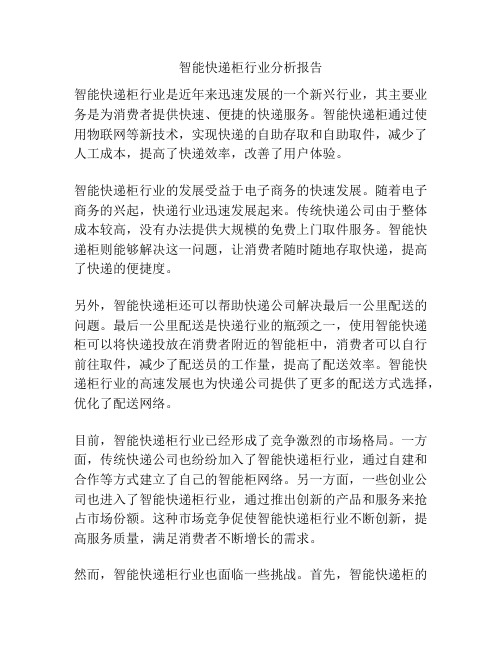
智能快递柜行业分析报告智能快递柜行业是近年来迅速发展的一个新兴行业,其主要业务是为消费者提供快速、便捷的快递服务。
智能快递柜通过使用物联网等新技术,实现快递的自助存取和自助取件,减少了人工成本,提高了快递效率,改善了用户体验。
智能快递柜行业的发展受益于电子商务的快速发展。
随着电子商务的兴起,快递行业迅速发展起来。
传统快递公司由于整体成本较高,没有办法提供大规模的免费上门取件服务。
智能快递柜则能够解决这一问题,让消费者随时随地存取快递,提高了快递的便捷度。
另外,智能快递柜还可以帮助快递公司解决最后一公里配送的问题。
最后一公里配送是快递行业的瓶颈之一,使用智能快递柜可以将快递投放在消费者附近的智能柜中,消费者可以自行前往取件,减少了配送员的工作量,提高了配送效率。
智能快递柜行业的高速发展也为快递公司提供了更多的配送方式选择,优化了配送网络。
目前,智能快递柜行业已经形成了竞争激烈的市场格局。
一方面,传统快递公司也纷纷加入了智能快递柜行业,通过自建和合作等方式建立了自己的智能柜网络。
另一方面,一些创业公司也进入了智能快递柜行业,通过推出创新的产品和服务来抢占市场份额。
这种市场竞争促使智能快递柜行业不断创新,提高服务质量,满足消费者不断增长的需求。
然而,智能快递柜行业也面临一些挑战。
首先,智能快递柜的安全性需要得到保证。
消费者对于将自己的物品存放在智能柜中,可能会担心物品的安全问题。
尤其是在一些居住区和写字楼等公共场所,人员流动较大,存在被盗的风险。
因此,智能快递柜企业需要加强安全措施,提升用户的信任度。
此外,智能快递柜行业还面临着政策法规的限制。
由于智能快递柜涉及到个人隐私和公共安全等问题,相关政府部门对智能快递柜的管理进行了一系列的限制。
智能快递柜企业需要与政府部门进行合作,提出合规方案,确保快递柜的合法运营。
综上所述,智能快递柜行业是一个发展潜力巨大的行业。
随着电子商务的快速发展和消费者对于快递便捷性的需求增加,智能快递柜行业的市场空间将会不断扩大。
基于智能快递柜的末端配送的盈利模式研究
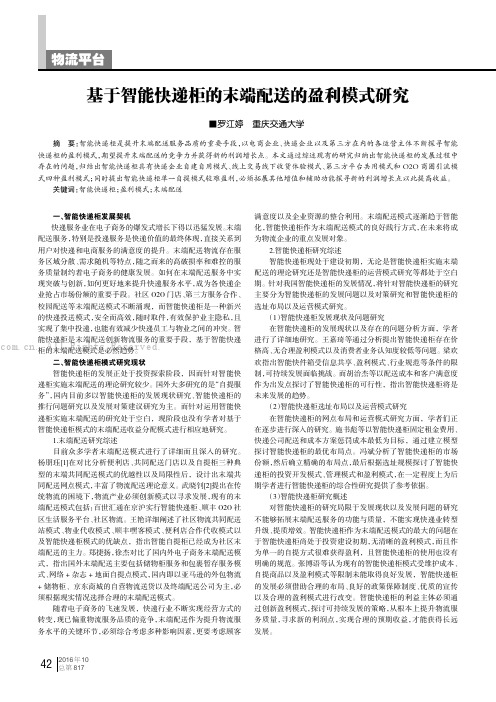
2016年10期总第817期一、智能快递柜发展契机快递服务业在电子商务的爆发式增长下得以迅猛发展。
末端配送服务,特别是投递服务是快递价值的最终体现,直接关系到用户对快递和电商服务的满意度的提升。
末端配送物流存在服务区域分散、需求随机等特点,随之而来的高破损率和难控的服务质量制约着电子商务的健康发展。
如何在末端配送服务中实现突破与创新,如何更好地来提升快递服务水平,成为各快递企业抢占市场份额的重要手段。
社区O2O 门店、第三方服务合作、校园配送等末端配送模式不断涌现,而智能快递柜是一种新兴的快递投送模式,安全而高效,随时取件,有效保护业主隐私,且实现了集中投递,也能有效减少快递员工与物业之间的冲突。
智能快递柜是末端配送创新物流服务的重要手段,基于智能快递柜的末端配送模式是必然趋势。
二、智能快递柜模式研究现状智能快递柜的发展正处于投资探索阶段,因而针对智能快递柜实施末端配送的理论研究较少。
国外大多研究的是“自提服务”,国内目前多以智能快递柜的发展现状研究、智能快递柜的推行问题研究以及发展对策建议研究为主。
而针对运用智能快递柜实施末端配送的研究处于空白,现阶段也没有学者对基于智能快递柜模式的末端配送收益分配模式进行相应地研究。
1.末端配送研究综述目前众多学者末端配送模式进行了详细而且深入的研究。
杨朋珏[1]在对比分析便利店、共同配送门店以及自提柜三种典型的末端共同配送模式的优越性以及局限性后,设计出末端共同配送网点模式,丰富了物流配送理论意义。
武晓钊[2]提出在传统物流的困境下,物流产业必须创新模式以寻求发展,现有的末端配送模式包括:百世汇通在京沪实行智能快递柜、顺丰O2O 社区生活服务平台、社区物流。
王艳详细阐述了社区物流共同配送站模式、物业代收模式、顺丰嘿客模式、便利店合作代收模式以及智能快递柜模式的优缺点,指出智能自提柜已经成为社区末端配送的主力。
郑捷扬,徐杰对比了国内外电子商务末端配送模式,指出国外末端配送主要包括储物柜服务和包裹暂存服务模式、网络+杂志+地面自提点模式,国内即以亚马逊的外包物流+储物柜、京东商城的自营物流送货以及终端配送公司为主,必须根据现实情况选择合理的末端配送模式。
- 1、下载文档前请自行甄别文档内容的完整性,平台不提供额外的编辑、内容补充、找答案等附加服务。
- 2、"仅部分预览"的文档,不可在线预览部分如存在完整性等问题,可反馈申请退款(可完整预览的文档不适用该条件!)。
- 3、如文档侵犯您的权益,请联系客服反馈,我们会尽快为您处理(人工客服工作时间:9:00-18:30)。
学生姓名: 学 学 专 号:
贾பைடு நூலகம்京
院:管理科学与工程学院 业: 项目管理
指导教师: 论文成绩:
内 容 摘 要
近些年,电子商务蓬勃发展带动了快递行业的快速扩张,尤其是 2009 年以来,各 大电商节给电商企业带来巨大交易量的同时, 也带给物流企业巨大的压力。 2011 年智能 快递柜作为缓解物流配送最后 100 米压力的解决方案开始在国内出现, 快递员可以直接 将快件投放至快递柜,业主也可以选择方便的时间取出。快递柜提高投递效率的同时也 保护了业主隐私。但在运营过程中也发现了诸多影响长远发展的问题。 目前一个标准快递柜生产成本至少要三万元, 高昂的前期投资限制了快递柜的规模 化增长;其次快递柜大多铺设在室外,恶劣天气及不良使用习惯导致硬件故障率居高不 下,维修投入较高;此外,快递柜行业盈利模式尚不清晰,多数企业持观望态度,不愿 意投入过多资源发展相关业务。 基于以上问题,本文提出基于微信公众平台的无屏快递柜解决方案,并将其作为研 究对象,采用理论结合实际的研究方式,对比分析行业主流快递柜与方正宽带无屏快递 柜,并通过层次分析法进行两方案的优选,突出体现无屏快递柜在节省成本、拓宽盈利 渠道方面的优点。最后对研究结果进行了总结,希望本文的研究能够对快递柜运营企业 提供一定的参考价值。 关键词:层次分析法 最后一百米 无屏 快递柜 微信
1
intelligent express cabinet laying outdoors, bad weather and bad habits lead to high hardware failure rate, maintenance investment in large; In addition, due to the current express cabinet profit model is not clear, the majority of companies hold a wait-and-see attitude, unwilling to invest too much resources to develop related businesses. Based on the above problems, this paper puts forward the solution of the no-screen express cabinet based on the WeChat public platform, and takes it as the research object, research methods by combining theory with practice, comparative analysis of the industry mainstream courier cabinet and Founder No-screen express cabinet,and optimization of two schemes by AHP,highlighting the advantages of No-screen express cabinet in the cost savings and broaden the channels. Finally, the research results are summarized, and it is hoped that the research of this paper will provide some reference value for express delivery enterprises. KEY WORDS: analytic hierarchy process cabinet wechat last hundred meter no-screen express
ABSTRACT
In recent years, with the rapid development of e-commerce, has brought a burst of explosive growth in numbers, especially since 2009, holiday promotions to bring huge trading volume, but also to the logistics Business great pressure. Since 2011, intelligent express cabinet as a solution began to appear in the country, used to relieve the last 100 meters of the pressure of the logistics. Couriers can be delivered to the intelligent express cabinet; the owners can also choose a convenient time to take out. Intelligent express cabinet to improve the efficiency of delivery while also protecting the privacy of the owners. But also found a number of issues affecting long-term development. At present a standard express cabinet production costs at least thirty thousand yuan, the high initial investment limit the size of the courier cabinet growth; Second, most of the
